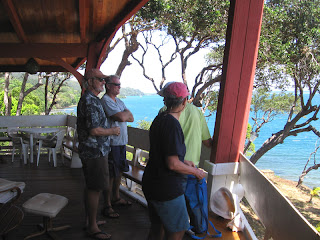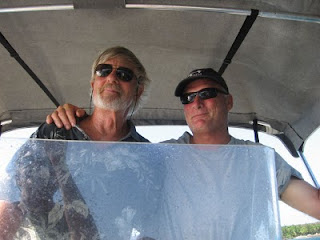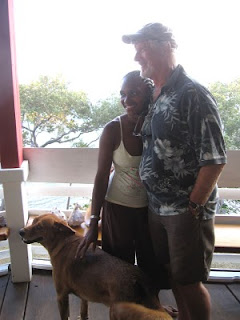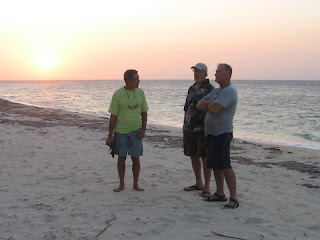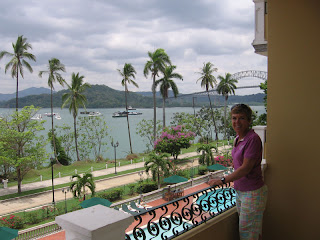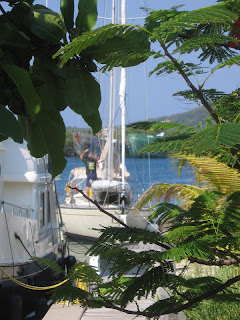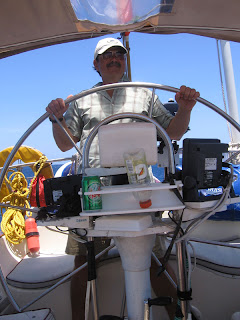 The next morning, after our terrific day with Eric and his family, we sailed the short distance around the corner to Roatan's West End and picked up a mooring. The idea was to shorten the distance we would need to sail to reach our next destination, Lighthouse Reef, off the coast of Belize, making it a long one-day sail instead of an overnight passage.
The next morning, after our terrific day with Eric and his family, we sailed the short distance around the corner to Roatan's West End and picked up a mooring. The idea was to shorten the distance we would need to sail to reach our next destination, Lighthouse Reef, off the coast of Belize, making it a long one-day sail instead of an overnight passage.The West End is Roatan's original tourist area. The beaches are beautiful and the snorkeling is surprisingly good. The still-unpaved road that runs parallel to the water is lined with funky shops and restaurants. The area seems to be a magnet for "trustafarians" and Lonely Planet types. Capt. John and I drank beers at a beachfront bar while Nan and Jan explored, and then we all dinghied back out to the boat for sundowners and Capt. John's jambalaya.
 We were up at dawn the next day to take full advantage of the available daylight. The southern entrance into Lighthouse Reef is tricky and cannot be navigated safely at night. We made good time surfing a broad reach most of the day, accompanied by dolphins feeding on the fish fleeing our wake. Unfortunately, the late afternoon light and significant wave action when we arrived at the reef made it too difficult to exactly locate the entrance. We dropped anchor in shallow water outside the reef, with the idea of spending the night and trying again in the morning, but the holding ground was poor and the water too rough. Capt. John made the decision to press on for Ambergris Caye, off the coast of Belize, and we sailed on. So much for the Great Blue Hole. Maybe next time.
We were up at dawn the next day to take full advantage of the available daylight. The southern entrance into Lighthouse Reef is tricky and cannot be navigated safely at night. We made good time surfing a broad reach most of the day, accompanied by dolphins feeding on the fish fleeing our wake. Unfortunately, the late afternoon light and significant wave action when we arrived at the reef made it too difficult to exactly locate the entrance. We dropped anchor in shallow water outside the reef, with the idea of spending the night and trying again in the morning, but the holding ground was poor and the water too rough. Capt. John made the decision to press on for Ambergris Caye, off the coast of Belize, and we sailed on. So much for the Great Blue Hole. Maybe next time. We arrived at San Pedro on Ambergris Caye early the next morning. Unlike Lighthouse Reef, the entrance through the protective reef was well marked. The water inside the reef was extremely shallow, so we ended up anchoring a few hundred yards offshore and dinghying in. The first order of business was to clear in with Customs and Immigration, but we arrived before they were open, so Nan and I wandered up and down the main drag looking for an Internet café and a cheap hotel room for much-needed showers. We found both but returned to clear in with the crew first before going our separate ways. We regrouped for lunch at Elvi's Kitchen, probably the most famous restaurant on Ambergris Caye. The food was excellent, as was the Belikin, Belize's one and only local beer.
We arrived at San Pedro on Ambergris Caye early the next morning. Unlike Lighthouse Reef, the entrance through the protective reef was well marked. The water inside the reef was extremely shallow, so we ended up anchoring a few hundred yards offshore and dinghying in. The first order of business was to clear in with Customs and Immigration, but we arrived before they were open, so Nan and I wandered up and down the main drag looking for an Internet café and a cheap hotel room for much-needed showers. We found both but returned to clear in with the crew first before going our separate ways. We regrouped for lunch at Elvi's Kitchen, probably the most famous restaurant on Ambergris Caye. The food was excellent, as was the Belikin, Belize's one and only local beer. After lunch, John and Capt. John spent time in an Internet café while Jan, Nan and I did some gift shopping. Belizean Arts Gallery and Toucan Gift Shop offered the best native arts and crafts we could find. We met up again late in the afternoon for a wet-bottomed dinghy ride back to where Quetzal was anchored and spent a quiet night on the boat in anticipation of another early departure the next day.
After lunch, John and Capt. John spent time in an Internet café while Jan, Nan and I did some gift shopping. Belizean Arts Gallery and Toucan Gift Shop offered the best native arts and crafts we could find. We met up again late in the afternoon for a wet-bottomed dinghy ride back to where Quetzal was anchored and spent a quiet night on the boat in anticipation of another early departure the next day. The final passage of our two-week trip was an overnight to Isla Mujeres, Mexico. Light winds on the second morning, as we passed Cozumel, prompted us to fly the spinnaker, but we doused all the sails as we approached the shallow water at Punta Sur, Isla Mujeres's southern point. Quetzal's old diesel engine, which had been giving us consistent trouble with overheating due to a worn-out heat exchanger, came close to calling it quits on the final stretch to Marina Paraiso, just south of the main downtown area. Capt. Doug Dorn, who met us in his dinghy to offer advice and assistance as we were approaching the marina, asked Capt. John why he didn't want to back into the slip instead of going in bow first. Capt. John told him that he was afraid the engine would give up for good if he shifted from forward to reverse; that's how close he thought it was.
The final passage of our two-week trip was an overnight to Isla Mujeres, Mexico. Light winds on the second morning, as we passed Cozumel, prompted us to fly the spinnaker, but we doused all the sails as we approached the shallow water at Punta Sur, Isla Mujeres's southern point. Quetzal's old diesel engine, which had been giving us consistent trouble with overheating due to a worn-out heat exchanger, came close to calling it quits on the final stretch to Marina Paraiso, just south of the main downtown area. Capt. Doug Dorn, who met us in his dinghy to offer advice and assistance as we were approaching the marina, asked Capt. John why he didn't want to back into the slip instead of going in bow first. Capt. John told him that he was afraid the engine would give up for good if he shifted from forward to reverse; that's how close he thought it was. Nan and I like to get off a boat when the trip is over instead of staying on until it's time to fly home. Mostly, it's a comfort thing: marinas are the hottest, buggiest, most humid places you could ever hope to stay. We had made reservations to stay at Color de Verano that night, in one of the new ground-floor studio units, so after we checked in with José in the marina office, we gave Louis, the owner, a call. He said he would open the unit for us, and I asked if he would also be willing to give us a ride there since he would be passing right by the marina on his way. He said he would pick us up in twenty minutes, so Nan and I hurriedly packed our duffel bags and made plans to meet the rest of the crew at Brisas Grill for dinner.
Nan and I like to get off a boat when the trip is over instead of staying on until it's time to fly home. Mostly, it's a comfort thing: marinas are the hottest, buggiest, most humid places you could ever hope to stay. We had made reservations to stay at Color de Verano that night, in one of the new ground-floor studio units, so after we checked in with José in the marina office, we gave Louis, the owner, a call. He said he would open the unit for us, and I asked if he would also be willing to give us a ride there since he would be passing right by the marina on his way. He said he would pick us up in twenty minutes, so Nan and I hurriedly packed our duffel bags and made plans to meet the rest of the crew at Brisas Grill for dinner.Louis and his wife Teresa have done a wonderful job with their Color de Verano building at the corner of Rueda Medina and Mateos. Nan and I had stayed there three times before, once in the third-floor apartment and twice in the penthouse, most recently for a month last fall. While we were there that last time, the ground floor, which once housed a coffee shop, was being converted into two studio apartments. They turned out beautifully, with creative art-deco touches and one-of-a-kind fixtures. Louis put us in the unit closest to the building's lobby, and after seeing how nice it was, we wished that we had made the reservation for two nights instead of just one, but Nan had been able to use credit card reward points to get a free night at the Privilege Aluxes hotel across the street for the next night.
 As we walked down Rueda Medina toward Brisas Grill, who should we see but our Spanish tutor from last fall, Juan Torres. He has been impossible to reach since then, and he told us the reason was that his computer had died, so he had no email access. I asked if he would be interested in having me pay him to translate the cookbook I am writing in conjunction with Juan Gomez's family into Spanish. He said that he would be, but then he shrugged when I told him he would need a computer. On a whim, I offered to give him my laptop. His face lit up immediately. We still need to work out how to get it to him, and I will need to buy a replacement laptop, but having Juan involved with the project will make a huge difference.
As we walked down Rueda Medina toward Brisas Grill, who should we see but our Spanish tutor from last fall, Juan Torres. He has been impossible to reach since then, and he told us the reason was that his computer had died, so he had no email access. I asked if he would be interested in having me pay him to translate the cookbook I am writing in conjunction with Juan Gomez's family into Spanish. He said that he would be, but then he shrugged when I told him he would need a computer. On a whim, I offered to give him my laptop. His face lit up immediately. We still need to work out how to get it to him, and I will need to buy a replacement laptop, but having Juan involved with the project will make a huge difference.Entering Brisas Grill was like a homecoming. Our great friend Juan Gomez greeted us with hugs, as did Ventura, Irving and the owner, Weimar. There were big smiles all around but obvious disappointment that we were there for only two days. We took a table on the beach and ordered two of Ventura's special margaritas. Capt. John, Jan and John joined us shortly and we all ate a fantastic dinner as the sun set on another day in paradise.
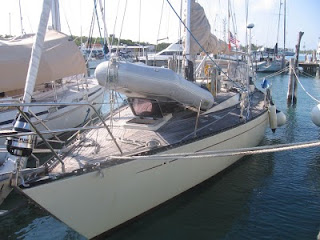 We had an appointment with Louis for the next morning. Back in January, when Nan and I were in Denver to celebrate her birthday, she had tossed out the idea of spending a year living in Isla Mujeres and renting Louis and Teresa's apartment overlooking Laguna Macax. We had looked at the apartment briefly during a previous visit when it was being built but had not seen it since its completion. Louis was more than happy to show it to us. He is rightly proud of the innovations he designs into everything he builds, whether it is a simple window or an elaborate chest of drawers. The apartment is located directly on the lagoon and has two levels, a main living area downstairs and a private rooftop deck with breezes and views upstairs. It would be perfect for us, and Louis said that our dog Scout would be more than welcome to join us.
We had an appointment with Louis for the next morning. Back in January, when Nan and I were in Denver to celebrate her birthday, she had tossed out the idea of spending a year living in Isla Mujeres and renting Louis and Teresa's apartment overlooking Laguna Macax. We had looked at the apartment briefly during a previous visit when it was being built but had not seen it since its completion. Louis was more than happy to show it to us. He is rightly proud of the innovations he designs into everything he builds, whether it is a simple window or an elaborate chest of drawers. The apartment is located directly on the lagoon and has two levels, a main living area downstairs and a private rooftop deck with breezes and views upstairs. It would be perfect for us, and Louis said that our dog Scout would be more than welcome to join us.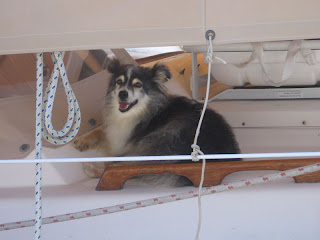 Nan and I returned to Brisas Grill for lunch and to make arrangements with Juan Gomez to stop by his house that evening with some gifts we had brought for his children. As we passed the beach across from Jax Bar and Grill on our way back to Color de Verano, we spotted Eloy, the old man who sells popcorn and chips on the beach, sitting on his adult tricycle with his basket full of snacks in the back. Last fall, we had noticed that he was in need of new shoes, so we promised we would get him some. We ran inside to get the new Reeboks we had brought for him and then ran out to the beach to give them to him. Eloy doesn't speak much English, but we could tell he was touched.
Nan and I returned to Brisas Grill for lunch and to make arrangements with Juan Gomez to stop by his house that evening with some gifts we had brought for his children. As we passed the beach across from Jax Bar and Grill on our way back to Color de Verano, we spotted Eloy, the old man who sells popcorn and chips on the beach, sitting on his adult tricycle with his basket full of snacks in the back. Last fall, we had noticed that he was in need of new shoes, so we promised we would get him some. We ran inside to get the new Reeboks we had brought for him and then ran out to the beach to give them to him. Eloy doesn't speak much English, but we could tell he was touched. We spent the rest of the afternoon moving across the street to the Privilege Aluxes hotel and reading on the beach. It was a relief to escape the unseasonable heat with a quick dip in the cool ocean. It made me wish we weren't leaving the next morning. We regrouped back in our room and then drove our rented golf cart down to Juan and Paula Gomez's home in the Salina Grande colonia. It was fun to spend time with the family and see the photos from their daughter Paulina's first communion. We talked briefly about the cookbook, and I told them about inviting Juan Torres to do the translation. They promised to take more photos of Paula's dishes and send them to me. I hope to have the book close to completion by the time Nan and I return for two weeks in September.
We spent the rest of the afternoon moving across the street to the Privilege Aluxes hotel and reading on the beach. It was a relief to escape the unseasonable heat with a quick dip in the cool ocean. It made me wish we weren't leaving the next morning. We regrouped back in our room and then drove our rented golf cart down to Juan and Paula Gomez's home in the Salina Grande colonia. It was fun to spend time with the family and see the photos from their daughter Paulina's first communion. We talked briefly about the cookbook, and I told them about inviting Juan Torres to do the translation. They promised to take more photos of Paula's dishes and send them to me. I hope to have the book close to completion by the time Nan and I return for two weeks in September. We met the rest of the crew that night at the central plaza and walked up Hidalgo to find a restaurant for our final meal together. We agreed on Rolandi's, Isla Mujeres's most popular restaurant for Italian food, and ate another excellent meal. We all had flights to catch the next morning, so we called it an early night and said our good-byes.
We met the rest of the crew that night at the central plaza and walked up Hidalgo to find a restaurant for our final meal together. We agreed on Rolandi's, Isla Mujeres's most popular restaurant for Italian food, and ate another excellent meal. We all had flights to catch the next morning, so we called it an early night and said our good-byes.

 Raising Charlie: The Lessons of a Perfect Dog
Raising Charlie: The Lessons of a Perfect Dog



